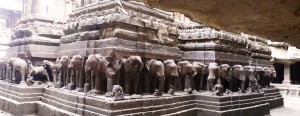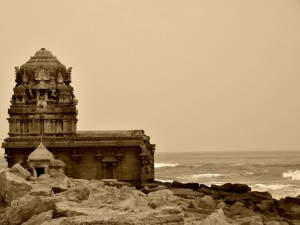
About a month ago I watched a movie called “The Monuments Men“, an American-German production directed by George Clooney, who also stars in the film along with a big superb cast, including Matt Damon.
This however, is not a review of the film.
A few reviews that I read after watching the film pointed out the historical inaccuracies in the film’s plot (the film claims to be based on true events). Some referred to other flaws in the film narrative, the lack of character development etc. But all that is too technical for my specific purpose here.
I
What I want to write about here is the idea behind the story. The idea is that while the whole world was burning under the massive flames of the inferno called World War II, there was a small but very important concern taking hold of some minds that the War was destroying not only millions of human lives and thousands of cities and towns, but was also posing a great danger to the innumerable pieces of art, architecture and sculpture, one of the greatest accomplishments of any civilization.
Saving art and sculpture in the middle of a most gruesome, horrible war? Can any piece of art be worth more than a human life? Would a group of dedicated art-enthusiasts really save some precious art without concern for their safety? Should they have taken that risk? The film brings out some of these questions. And I, for one, thought that it was worth reflecting on those questions because they challenge us to think about the conflict that often arises between saving the life of human beings and the life of humanity. They challenge us to reflect upon the fact that a culture, a civilization is a living, breathing thing, which must be protected and aggressively defended, even in the middle of a war.
Sri Aurobindo defined culture thus:
“The culture of a people may be roughly described as the expression of a consciousness of life which formulates itself in three aspects. There is a side of thought, of ideal, of upward will and the soul’s aspiration; there is a side of creative self-expression and appreciative aesthesis, intelligence and imagination; and there is a side of practical and outward formulation.”[1]
The film’s premise, especially the true historical events which inspired the film ,really provoke the audience to reflect upon the value and necessity of all possible efforts that must be made to preserve and conserve the highest accomplishments and achievements of a culture’s creative self-expression and aesthetic imagination.
It compels the audience to think deeply on the need for an aggressive defence of a culture and its highest accomplishments against all barbarism, whether it is an invasion from outside or a parasite from within. It certainly made me recall this important word of caution given by Sri Aurobindo:
“The culture which gives up its living separateness, the civilisation which neglects an active self-defence will be swallowed up and the nation which lived by it will lose its soul and perish.”[2]
That is what the art-enthusiasts in the film were trying to do. They were trying to protect and defend that which made their culture living and unique. They were ready to sacrifice their lives to protect and defend the finest accomplishments of their civilization which were under grave danger. An idea like this in itself makes the film worthwhile in my subjective view.
But at times a film can be much more than a mere movie one watches for entertainment. It can become a thought-provoking and reflective exercise if we are willing to go a bit beyond the film’s original narrative.
II
Three other lines of thought, that make this particular film even more interesting for my analysis here, are actually not in any way part of the film’s story-line or narrative. Yet they deserve some attention and reflection in order to better appreciate the premise of the film.
When watching the film, I realized that there was this thought in a part of my mind which at times even made me feel a little disconnected from the film. While I appreciated this wonderful example of how some of the best art and sculpture produced over many centuries of Western civilization was being so courageously protected and defended by those who understood the significance and value of art and heritage, I couldn’t help but recall that part of our world history which saw the same Western civilization as the perpetrator of massive destruction of many wonderful human accomplishments – in art, sculpture, systems of education, ways of life, languages, religions.
World History is full of examples of how indigenous cultures and civilizations in many parts of the world have had to face the destructive might of the West, in the name of imperialism, colonialism, settlement, civilizing mission, (and now economic globalization). The present state of native cultures throughout the American continents speaks for itself. Those on the civilizing mission might not have always needed to decimate physical structures, but the kind of loss of culture and civilization that occurs when indigenous ways of life, religious traditions, and systems of living and social organization are destroyed, displaced and uprooted under the name of colonialism and settlement is irreplaceable. I can’t get rid of the mental unease when I recall that the creations of these same destroyed cultures have now become part of museum exhibits. I can’t help but recall that such devastation of cultural heritage happened as recently as the war in Iraq.
A part of my mind wants to wander around this issue. But the other part clearly understands that the film is not about that, that the story was set in a very particular historical moment and that’s what it is concerned with. And this part of me also understands that in the post-colonial era we have also seen the West take serious interest, and in many cases provide strong leadership, in preserving and protecting the art, monuments and other heritage of several indigenous cultures, both in the West and East. The heightened awareness and greater sensitivity that all this is our shared world heritage is in many ways gradually erasing the division of cultural attackers and cultural defenders. And yet cultures, especially those that are firmly rooted in great traditions from the past, cannot afford to be passive in this fast globalizing world. Often the older cultures are more vulnerable to the loss of their heritage because of the fast-paced and often mindlessly executed attempts to modernize and globalize.
And this brings me to the second point.
This point, which again is not part of the film’s plot or narrative, but which made the experience more thought-provoking for me, is particularly relevant to India. A part of my mind wandered to the most violent and brutal destruction that had been unleashed by various invaders on India’s finest sculptural and architectural wealth. This has been well documented by many historians though some of this historical evidence has also been politicized for various reasons. But an undeniable truth is that the ruins of India’s glorious heritage and civilization are scattered all over her landscape for anyone to see. Thousands of broken stones and beheaded statues in thousands of Indian temples and cave-monasteries built thousands of years ago speak the story of the massive destruction they had once gone through at the hands of invaders and looters.
Kailash cave-temple, Ellora
They also speak the sad story of how even today India is not fully awakened to the need of protecting and defending this great heritage, these great accomplishments of her culture and civilization. The threat this time is not from outside invaders, but from in-house ignorance, indifference, neglect, and total disregard. The threat this time is not so much from bullets and machine guns, but more from the home-grown weapons of mass delusion on the glories of commercial-consumerist-mechanical-materialistic view of life, that are launched incessantly by aggressive marketers.
Some of this threat arises from the fact that mainstream Indian education, for the most part, doesn’t inculcate a sense of healthy pride and respect among Indian children and youth for their cultural heritage, civilizational ethos and history. This is not difficult to correct but the will must be there in order to make it happen. While there are many organizations – public and private – that are working hard to create awareness among the Indian public, especially the children and youth through educational programmes and campaigns, the fact also remains that we still see a lot of silly things like scribbling names on monuments and littering. While there are larger institutions like the Archaeological Survey of India and several others which are given the responsibility of protecting and preserving the various monuments and architectural wonders of Indian heritage, it is also true that much more remains to be done in that area.
Just last month on a visit to Tharangambadi (Tranquebar) in Tamil Nadu, I saw the dilapidated condition of the 700-year-old Masilamani Nathar temple, while the nearby Danish Fort and several other houses from Danish settlements are being carefully preserved by private organizations. Last year I visited several temples in Kumbakonam and other smaller towns of Tamil Nadu, many of which seemed to be crying out for proper care and attention.
At the same time I was very happy to see the wonderful work being done to preserve and bring back the glory of bigger temples like the ones at Thanjavur, Gangaikondacholapuram, and Kanchipuram. Two years ago when visiting Ellora caves in Maharashtra I was sad to see so much decay and lack of upkeep at a place as grand and glorious as the Kailashanatha cave temple. On the other hand, much effort is being put into preserving and bringing back the glory of the nearby Ajanta caves with the help of UNESCO and several other international organizations.
True, much is being done but much still remains to be done. And this brings me to the third point.
There is a lot that India can and must learn from the West, especially about how to carefully preserve and conserve our heritage. Like the West, we Indians need to become more mindful and aware of the need to aggressively defend and protect our culture and its finest accomplishments – be it in sculpture, art, literature, traditions or ways of life. It starts with Indians becoming aware of and proud of their heritage and culture. And in this department too we can learn a lot from the West – how to be proud of our cultural accomplishments while at the same time keeping a broader, global outlook.
While much can be learnt in the area of technological know-how but when it comes to preservation and conservation, what is more important to observe and learn from the West is the general attitude of the larger society – or at least some sections of society – on how to compel and support the concerned government departments and non-governmental organizations and authorities to put their best foot forward in protecting and preserving the great accomplishments of our past heritage. Having lived in the US for many years, I have seen first-hand how socially aware and concerned individuals and groups, even in small towns and communities, are about their local museums and other important buildings of architectural value and significance. That kind of attitude is generally missing for the most part among the educated Indian middle-classes. Perhaps some of it is because of the various other challenges people face in a country like India, but I also feel that some of it is simply because of apathy, indifference, lack of interest and nothing else.
III
Let me conclude this non-review of the film ‘The Monuments Men’ by saying that while the film may not be a great film as such, it certainly compels the audience (at least it compelled me) to reflect upon a few very important questions about the significance of art and all other high aesthetic accomplishments in a civilization’s evolutionary march.
The film forces us to ask ourselves if we are doing enough to defend and protect those achievements of our past which have given our culture and civilization a unique stamp. It raises the question whether the future of a civilization depends on the extent to which the present generation can preserve and protect the finest splendours that have been handed over to them from the generations past.
References:
[1] Sri Aurobindo, The Renaissance in India and Other Essays on Indian Culture, (Pondicherry, Sri Aurobindo Ashram Publication Department, 1997), 106
[2] Ibid., 57







